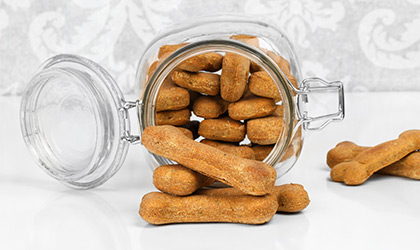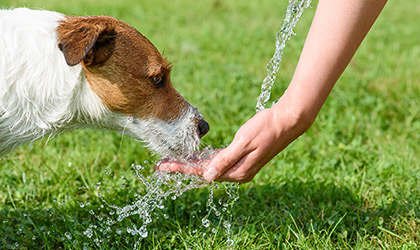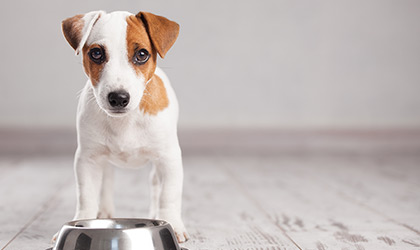
Imagine if you could only eat one meal for the rest of your life. Not only would it be mind-numbingly boring, but you’d question whether it was meeting all your nutritional needs, wouldn’t you? Oh, the joys of a pet’s life. If you fancy adding some colour and spice to your furry friend’s humdrum diet, homemade pet food is a winner, paws-down. Creating your own food extends beyond simply appeasing finicky felines or picky pooches (although, mark our words, this definitely does help); rather, it allows you to provide your companions with a comprehensive range of essential nutrients – wholesome goodness that you wouldn’t usually find stacked on your supermarket shelves.
Preparing your own pet food is pretty simple, but you need to follow some golden rules: firstly, it needs to consist of more than just table scraps; and secondly, it must be well balanced. We’re talking about finding that sweet spot between protein, carbohydrates and fats, and ensuring all meals are brimming with antioxidants and micronutrients too. The best part about making your own pet food is that you have total autonomy over what goes into it. You don’t need to worry about additives, poor quality ingredients, or cheap fillers. Better still, if your four-pawed companion has an allergy, you can cater for it – no problem! To make sure you’re not barking up the wrong tree, consult your local vet before indulging your animals in any new culinary creations. Vets have a wealth of knowledge when it comes to pet nutrition – and you never know, they may even have a recipe or two up their white-coated sleeves...
Raw vs. cooked?
The raw pet food diet has gained a lot of popularity in recent years. As the name would suggest, this regimen is based on feeding your furry friends raw meat, veggies and grains – just like they would’ve eaten thousands of years ago. Despite some vets advocating this diet, there are some pretty big holes in the idea. It boils down to the potential for human error, really. Feeding your pets raw or undercooked animal proteins may expose them to potentially toxic pathogens that could make them seriously unwell. Worse still, these bacteria can be transmitted to humans too. Yikes! To prevent the risk of such contamination, we’d always suggest thoroughly cooking any pet food you whip up.
Homemade dog food
All canine-friendly recipes should consist of the following daily nutritional ratios:
-
60% protein (seafood, animal meat, dairy or eggs): for muscle growth and tissue repair
-
30% carbohydrates (vegetables and grains): for energy and digestive health
-
10% fat (meat, oil or egg yolks): for a shiny coat, healthy joints and the absorption of fat-soluble vitamins
-
Calcium (from crushed egg shells or a supplement): for optimal bone health
A little disclaimer: we haven’t included a serving size in our recipes, since portions depend on a number of factors like the breed, age and health of your dog. Consult your vet if you’re unsure about how much you should feed your hungry hound.
Turkey, rice and vegetable dog food
If your pooch is looking a little porky, this is an excellent recipe for keeping him in shape. Enriched with a nutritious balance of protein, complex carbs and veggies, this meal will nourish your four-pawed friend from nose to tail. It can be refrigerated for up to 5 days too.
Ingredients
450g ground turkey mince
2 cups brown rice
6 cups water
1 tsp. dried rosemary
½ cup frozen carrots, broccoli and cauliflower
Directions
-
Place the water, rice, ground turkey and rosemary in a large cast iron pot
-
Stir the mixture until the meat is evenly distributed throughout
-
Bring to the boil, and then reduce to a simmer for 20 minutes
-
Add the frozen veggies and cook for another 5 minutes
-
Remove from the heat and leave to cool before serving
-
Store in an air-tight container and refrigerate for up to 5 days
Beef stew
Loaded with tons of vitamins and fresh protein, this dish is a brilliant alternative to traditional canned dog food. This will keep in your fridge for the best part of a week.
Ingredients
450g of stewing beef
1 small sweet potato, chopped into bite size chunks
½ cup of carrots, finely chopped
½ cup of green beans, diced
½ cup flour
½ water
1tbsp. vegetable oil for frying
Directions
-
Boil the sweet potato until tender
-
Slice the beef into smaller chunks, and fry in a tbsp. of vegetable oil on a medium heat for 10-15 minutes, or until well-done
-
Remove the beef from the pan, setting aside the fat drippings
-
Heat the fat over a medium-low heat. Add the flour and water gradually, and whisk to create a thick gravy
-
Add the sweet potato, meat, beans and carrots to the gravy, and cook until tender (approximately 10 minutes)
-
Allow to cool, then serve
-
Store in an airtight container and refrigerate for up to 5 days
Homemade cat food
As with your canine culinary creations, homemade cat food requires certain must-haves:
-
60% protein (animal meat, organs or fish): for muscle growth and tissue repair
-
30% animal fat: for a shiny coat, healthy joints and the absorption of fat-soluble vitamins
-
10% carbohydrates: for energy
-
Calcium (from a supplement): for optimal bone health
Again, you’ll notice we haven’t provided any serving guidelines, as they can vary from feline to feline. Consult your vet if you need advice on how much to feed your little fur ball.
Chicken cat food
If you were fluent in feline tongue, then you’d know that cats go weak in the furry knees for chicken. This recipe is oh-so-simple – not to mention nutritious. Your four-pawed friend will love it!
Ingredients
250g cooked chicken
¼ cup steamed broccoli, mashed
¼ cup steamed carrots, mashed
Unsalted chicken stock
Directions
-
Place all the ingredients in a blender with a little stock
-
Blend until the mixture resembles ‘wet cat food’. Add more stock if needed, but ensure it’s not too ‘soupy’
-
Allow the food to cool before serving
-
Store leftovers in an air-tight container and refrigerate for 3 days
Rabbit stew
This protein-rich supper will have kitty smacking his chops and purring his little heart out. Keep any leftovers in the fridge for the remainder of the week.
Ingredients
250g rabbit meat, cut into small pieces
20g of diced sweet potato, carrot, celery and peas
1 tsp. olive oil
Dash of thyme, parsley and rosemary
Unsalted vegetable stock
Directions
-
Over a medium-low heat, sauté the rabbit in olive oil
-
Add the vegetable stock, herbs and bring to the boil
-
Reduce the heat and cook through thoroughly
-
Add the veggies and simmer for another 45 minutes
-
Allow to cool, and then serve
-
Store any leftovers in an airtight container and refrigerate for up to 3 days.
Take home message
Even if you’re not a whizz in the kitchen, homemade pet food is an exciting way to add some pizzazz to your furry companion’s diet – it certainly beats kibble, that’s for sure. Remember though, your canine and feline friends have specific nutritional needs. All recipes, therefore, should be cooked exactly as instructed – sadly, this isn’t the occasion to add a sprinkle of this or a dash of that. Finally, be sure to cook all animal products, starchy vegetables and grains through thoroughly for a deliciously digestible dinner. Above all, enjoy your new rank as pet chef! Your little fur balls certainly will.
References:
-
Pets4Homes. (2018). The benefits of homemade dog food. Available online: https://www.pets4homes.co.uk/pet-advice/the-benefits-of-homemade-dog-food.html
-
Whole Dog Journal. (2012). How to make your own dog food. Available online: https://www.whole-dog-journal.com/issues/15_7/features/Home-Prepared-Dog-Food-Nutritional-Information_20568-1.html
-
Care 2. (2012). How to make your own cat food. Available online: https://www.care2.com/greenliving/gourmet-kitty-homemade-cat-food.html



